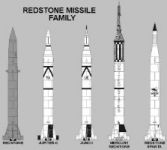
Redstone Family
U.S. Manned Rocket Propulsion Evolution
Part 4.1: The Redstone Missile
Compiled by Kimble D. McCutcheon
Published 7 Dec 2020; Revised 3 Aug 2022
Abbreviations, Acronyms and Glossary
Background
ORDCIT - Readers may recall that Aerojet, which was closely associated with the California Institute of Technology and its Jet Propulsion Laboratory (JPL), was building both solid and storable-liquid JATO units for the USAAF. In early July 1943, the AAF Materiel Center at Wright Field asked Theodore von Kármán to review three British Intelligence reports on German reaction propulsion devices. This led to continued research into solid and storable-liquid propellant JATO units, air-to-underwater missiles, ramjet research, and a consortium of the Army Ordnance Division and the California Institute of Technology called ORDCIT. ORDCIT ultimately built a series of solid-propulsion sounding rockets dubbed Private A and Private F, and a storable-propellant sounding rocket, the WAC Corporal. [Malina, Frank J. "America's First Long-Range-Missile and Space Exploration Program: The ORDCIT Project of the Jet Propulsion Laboratory, 1943-1946: A Memoir" Fifth History of Astronautics Symposium of the International Academy of Astronautics (Brussels, Belgium, Sep 1971).]
Reaction Motors (RMI) continued to experiment with an develop liquid-fueled rocket engines throughout WWII, and activity that culminated in 1945 when RMI secured a contract for the rocket engine that ultimately allowed Chuck Yeager to break the sound barrier on 14 Oct 1947 in a Bell X-1 airplane. RMI went on to build other rocket X-plane rocket engines, including the XLR99, which powered the NAA X-15. [https://en.wikipedia.org/wiki/Reaction_Motors]
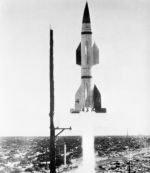 |
| Hermes A-1 (Wiki) |
Project Hermes started on 20 Nov 1944 when General Electric was given a research and development contract to pursue long-range surface-to-surface and surface-to-air missiles and the associated investigations, research, experiments, design, development, and engineering work. GE was also to develop remote control equipment, ground equipment, fire control devices, and homing devices, as well as to investigate ramjets, solid rocket motors, liquid propellant rocket engines, and hybrid propellants. The contract also required the General Electric Company to develop remote control equipment, ground equipment, fire control devices, and homing devices. This led to a series of missile designs, as well as coordinating the activities of the German Project Paperclip scientists and engineers at Ft. Bliss, Texas and the White Sands Proving Grounds in New Mexico. GE's role culminated with a series of studies called Hermes C, which led directly to the Redstone. [https://en.wikipedia.org/wiki/Hermes_Project]
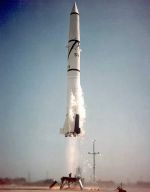 |
| Redstone (Wiki) |
Project Redstone
As the reader may have surmised, U.S. rocketry research was sporadic, disorganized and low-priority during WWII. The Army, Army Air Forces and Navy each pursued its own rocketry programs, which often duplicated one another and squandered resources. After WWII, the service branches argued about the most effective way to fight a nuclear war. In 1947, when the Air Force became an independent military branch, Army missile research and development was largely directed toward tactical surface-to-surface missiles with ranges less than 1,600 km and surface-to-air missiles, while the new Air Force under strategic missile development was directed toward longer-range strategic missiles. Navy, with a different set of requirements eventually went its own way.
In 1950, after studying both domestic and German designs, along with Cold War plans, the Army decided it needed a missile that could carry a 1,000 lb warhead 500 miles. The Ordnance Guided Missile Center (OGMC), established at Redstone Arsenal near Huntsville, Alabama on 15 April 1950, had responsibility for the missile's design, construction and testing. The OGMC was staffed largely by the German engineers and their American counterparts that had previously been working out of Ft. Bliss, Texas. This design produced the Redstone (PGM-11) missile.
Redstone relied heavily on the V-2 propulsion and guidance technology with which the OGMC was familiar, but also featured much that was new. The propulsion system was an adaptation of the XLR-43-NA-1 engine that North American had developed for Navaho. Compared to the V-2, this engine had half again as much thrust, was much small, lighter, easier to build and easier to operate. It also had a rudimentary automatic turbopump speed control that regulated pressure to the peroxide tank, keeping the engine thrust more uniform in flight and allowing controlled thrust decay at cutoff.
The Redstone guidance system was an evolutionary development of the proven V-2 system. Carbon vanes in the exhaust, coupled with an aerodynamic tab on each of the four fins, controlled the missile's roll, pitch and yaw, ensuring it followed a pre-programmed trajectory. Unlike the V-2, the Redstone warhead separated from the booster before reentry, which meant the booster now did not have to withstand the heat and dynamic pressure of atmospheric reentry; this feature also improved the warhead's placement accuracy.
In February 1951, Redstone payload requirements changed so that it had to loft the W-39 warhead, a 3.8 MT thermonuclear bomb weighing around 6,300 lb, a distance of about 175 miles with a Circular Error Probable (CEP) of 1000 ft. CEP, a measure of missile accuracy, is the radius of a circle, centered at the intended target, within which 50% of the missiles would be expected to impact. Redstone had a maximum range of about 200 miles. [https://en.wikipedia.org/wiki/PGM-11_Redstone]
Redstone Description
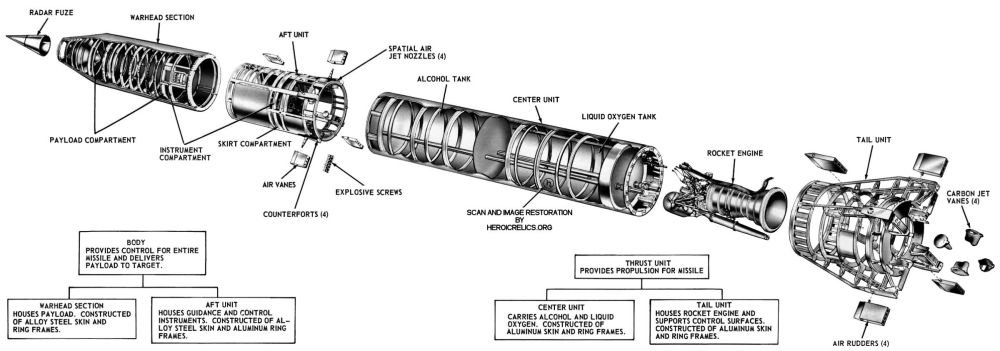 |
| Redstone Exploded View Showing Components (heroicrelics.org) |
The Nose Unit or warhead consisted of an alloy steel skin riveted and welded to alloy steel ring frames and stringers. This construction allowed the nose unit to withstand the 1,000°F and 95 psi reentry temperature and dynamic pressure.
The Aft Unit, fabricated of an alloy steel skin riveted to aluminum allow ring frames and stringers, was composed of a forward pressurized instrument compartment and an aft skirt section. The instrument compartment housed the guidance and control equipment. The skirt section housed two spheres that supplied high-pressure air to pneumatic systems. Equally spaced around the aft unit base were four air vane mounting pads, called counterforts. Four actuators, one inside each counterfort, were connected to air vanes. On either side of the each counterfort was a hex-shaped jet nozzle through which bursts of high-pressure air exited. The jet nozzles achieved payload guidance after booster separation and at extreme altitude while the air vanes controlled final targeting as the warhead descended into more dense atmosphere. Six ball fittings located on the aft ring frame mated with corresponding socket fittings on the missile center unit forward ring frame. Explosive screws threaded into tapped holes in the ball fittings held the aft unit to the center unit. A similar arrangement, but without the explosive screws, attached the nose unit to the aft unit.
Prior to launch, the guidance compartment was heated or cooled in order to maintain a temperature of about 60°F. A heater-cooler drop tank, attached to the guidance compartment exterior, contained a heater, blower, and a tank filled with dry ice cubes in Block I missiles or liquid nitrogen in Block II missiles. Air from the instrument compartment was forced by the blower through the heater-cooler and conditioned as required. When the firing switch was actuated the drop tank was released and fell to the ground.
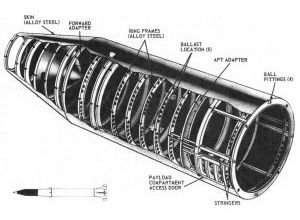 |
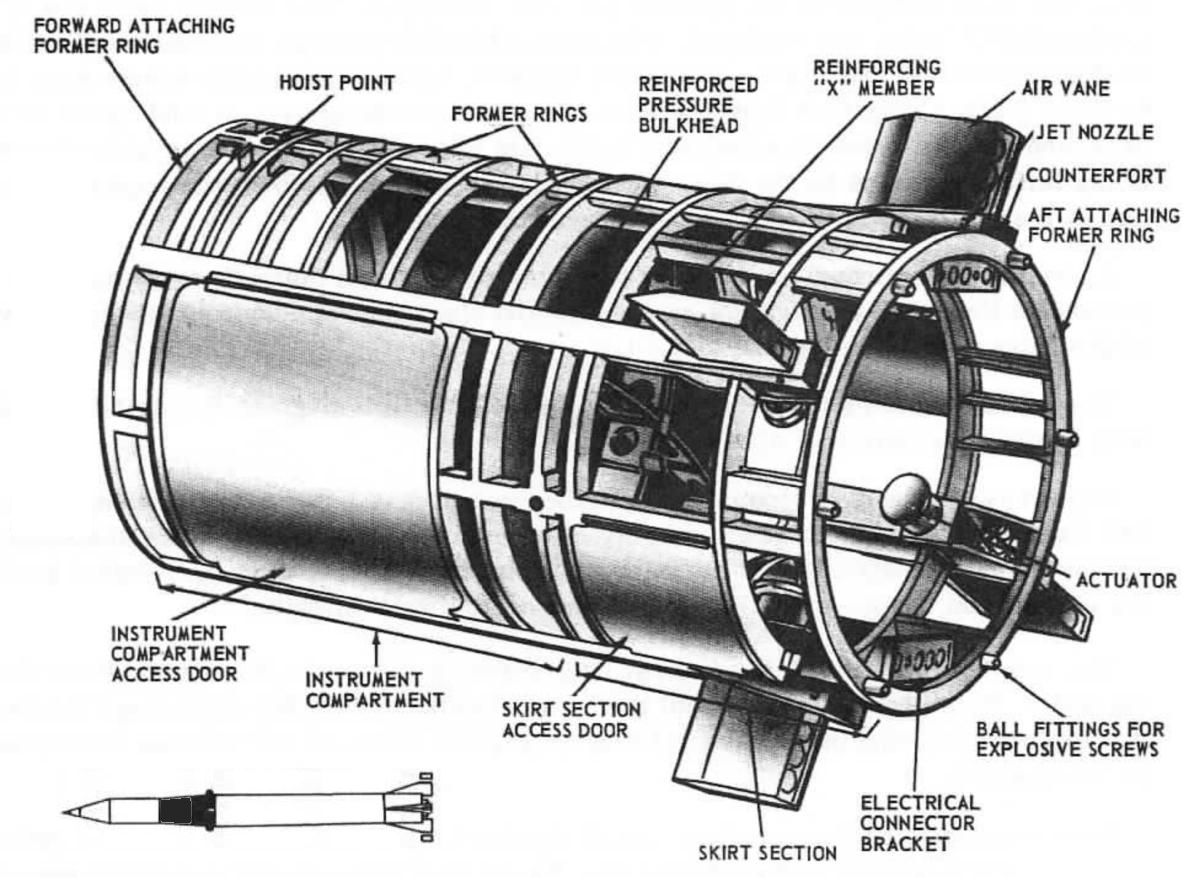 |
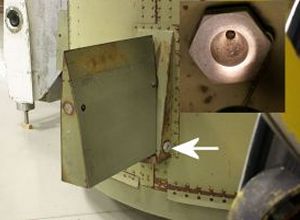 |
| Redstone Nose Unit (heroicrelics.org) | Redstone Aft Unit (heroicrelics.org) | Redstone Air Vane and Jet Nozzle (heroicrelics.org) |
The Center Unit, which did not have to survive reentry, was fabricated from aluminum alloy skin and ring frames; it housed the propellant tanks. An alcohol tank was located forward, and a LOX tank aft. Both tanks were pressurized to about 30 psi to prevent collapse as propellants were used and to prevent turbopump cavitation. A conduit running through both tanks accommodated electrical cables and pneumatic lines. Four vane locking rods extended forward from the center unit engage the aft unit vanes, preventing their movement until separation occurs. The aft ring frame had provisions for attachment of the tail unit and engine mount.
The Engine Mount was a steel tubing weldment, bolted to the center unit aft flange, which carried the engine, turbopump, steam generator and related components. Surrounding the engine and engine mount was the Tail Unit, a riveted aluminum alloy cylinder with four stabilizing fins that was bolted to the center unit. Within the tail unit were high-pressure air supply spheres, guidance and electrical components. At the tail unit base were connectors for ground-support air, LOX, and electrical systems. Each of the four fins incorporated an jet vane, and air rudder, and a pneumatic actuator, all of which guided the missile during its launch phase.
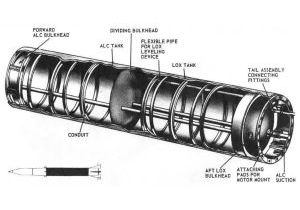 |
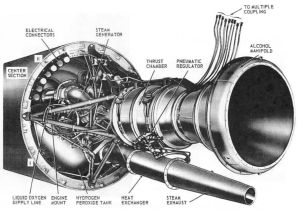 |
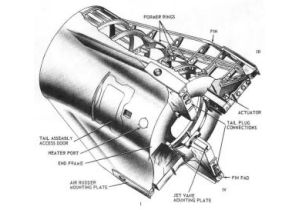 |
| Redstone Center Unit (heroicrelics.org) | Redstone Engine Mount (heroicrelics.org) | Redstone Tail Unit (heroicrelics.org) |
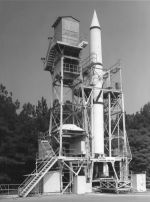 |
| The Interim Test Stand (NASA) |
Redstone Ground Testing
The Ordnance Missile Laboratories (OML) was formed in September 1952 to coordinate research and development within the OGMC. Holger Toftoy, was promoted to Brigadier General and directed the OML. Kurt H. Debus, who had been the flight test director at Peenemünde led the OML Experimental Missile Firing Branch, and was responsible for the Interim Test Stand at Redstone Arsenal, along with Cape Canaveral facilities for Redstone, Jupiter, Jupiter-C, Juno I, Pershing and Saturn.
In late 1952, when it came time to assemble and test the Redstone, a test stand was needed. The Army was flush with research and development funds, but was prohibited from spending any R&D money on facilities. Getting facilities money would require a two-year Congressional funding cycle. With a $25,000 spending limit, engineers scoured Redstone Arsenal for scrap material from which they could build an "interim" test stand. Rough sketches drawn on scrap paper replaced blueprints. Welders constructed a small structure that was anchored to a reinforced-concrete foundation that had had consumed most of the $25,000. With no money for control equipment and recording instrumentation bunkers, two abandoned railroad tank cars were cleaned, outfitted, and buried under earth mounds about 100 yards from the test stand. This "interim" test stand not only got the Redstone missile flying, but was used well into the 1960s for engine testing on other projects, such as the Jupiter engine and man-rating the Mercury-Redstone. [https://en.wikipedia.org/wiki/Redstone_Arsenal, https://en.wikipedia.org/wiki/Kurt_H._Debus]
Redstone Flight Testing
Redstone first flew from Cape Canaveral, Florida on 20 Aug 1953, but the test flight only lasted for 80 seconds before its guidance system failed, causing an engine failure. A second launch on 27 Jan 1954 was a complete success, with its dummy payload splashing down 55 miles downrange in the Atlantic Ocean. Next, an inducer was added to the LOX pump entrance to reduce the likelihood of cavitation. Flight three took place on 5 May 1954, but this one only lasted one second before the engine cut off, allowing the missile to fall back to the launch pad and explode.
Von Braun told his team, "Missile reliability will require that the target area is more dangerous than the launch area." Workmanship standards were enhanced and Redstone reliability improved until the missile became operational in 1955. [https://en.wikipedia.org/wiki/Redstone_Arsenal]
A total of 57 Redstone missiles were used for research and development. Seven of these never flew, but were used for training and miscellaneous ground tests. Of the remaining 50 missiles, only 37 were used for R&D flight tests. Of these 37, 9 were used for propulsion and airframe tests, 18 for propulsion, airframe and guidance tests, and 10 for propulsion, airframe, guidance and payload tests. However, only 12 of the 37 were solely dedicated to Redstone program testing. The other 25 were used in Jupiter missile program development. Special missiles were built to test Jupiter nosecones, launch earth satellites, for Project Mercury, and for Operation Hardtack, which launched two nuclear weapons that were exploded high in the atmosphere.
| Type | Number (details) |
|---|---|
| Redstone Development | 12 |
| Jupiter-A | 25 |
| Jupiter-C | 3 (RS-27, RS-34, RS/CC-40) |
| Special Tests | |
| Juno I | 6 (Explorer I thru V, RS-29, RS/CC-26, RS-24, RS/CC-44, RS/CC-47, RS/CC-49) |
| Mercury | 6 (MR-1, MR-1a, MR-2, MR-BD, MR-3, MR-4) |
| Hardtack | 2 (CC-50, CC-51) |
| Block I Tactical | 17 |
| Block II Tactical | 18 |
| RS = Built by Redstone Arsenal CC = Built by Chrysler Corporation Missile Division | |
Production and Service
The Chrysler Corporation Missile Division (CCMD) secured the Redstone production contract, NAA (now Rocketdyne) the engine contract and Sperry Rand Corporation's Ford Instrument Company the guidance and control system based on the ST-80 stabilized platform. The OGMC became the Army Ballistic Missile Agency (ABMA) on 1 Feb 1956. The ABMA built 27 Redstone missiles and CCMD built 101. The Redstone was in active service with the U.S. Army in Germany from June 1958 through June 1964. CCMD built 19 Block 1 Missiles and 44 Block II missiles. Block I missiles used the NAA 75-110-A-6 engine and a dry-ice-cooled heater-cooler drop tank; Block II missiles used the NAA 75-110-A-7 engine and a liquid-nitrogen-cooled heater-cooler drop tank. When improvements in solid rocket propulsion rendered the Redstone and other liquid-propellant missiles obsolete, Redstone production stopped in 1961, replaced by the Pershing missile system.
When fully developed, the Redstone was 69.32 ft high, 6.00 ft in diameter, had a 12.00 ft fin span, and weighed 61,680 lb, 7,890 lb of which was payload. Its engine produced 82,617 lbT when fueled by a 75/25 ethanol/water mix and LOX.
Although presumably mobile, a Redstone missile battalion comprised 20 heavy vehicles. Once at a launch location, it took eight hours to survey the site, assemble the missile, mount it on the launch table, align the inertial navigation system, and check it out for launch. Once a launch order was given, it took another 15 minutes to fill the oxidizer tank before the actual launch could occur. [https://en.wikipedia.org/wiki/Redstone_Arsenal, http://www.astronautix.com/r/redstone.html]
According to Jim Ryan, who was a member of a Redstone missile Firing Battery, "A Redstone missile firing exercise was listed as a nominal 8-hour operation. However, in West Germany in 40th Artillery Group (and I am sure in 46th Group also) we were constantly being pushed and cajoled into completing the fire mission in 5 hours, with the Group’s two Firing Batteries in essence placed in competition with the other. Without drastically cutting steps, or safety measures, we in Battery A were able to achieve this goal on a regular basis, and on several occasions had the time from first occupying a firing site to ‘hitting the firing button’ down to about 4 hours and 45 minutes, including working numerous times overnight under the cover of darkness." Jim has written a great account of his experiences in My Army Redstone Missile Days.
| Type | Total | RSA | CCMD | Launched |
|---|---|---|---|---|
| Development | 43 | 20 | 23 | 37 |
| Jupiter-C | 12 | 5 | 7 | 9 |
| Mercury | 8 | 2 | 6 | 6 |
| Hardtack | 2 | - | 2 | 2 |
| Block I | 19 | - | 19 | 17 |
| Block II | 44 | - | 44 | 18 |
| RSA = Redstone Arsenal CCMD = Chrysler Corporation Missile Division | ||||
Jupiter A
Von Braun and his team started planning Jupiter, a longer-range ballistic missile, in 1954. The five-fold range increase (200 to 1000 mi) was a huge challenge, one that required developing new propulsion, guidance and structures. Von Braun used modified Redstone missiles as test beds for Jupiter technology. Only 12 of the 37 Redstone test missiles were used solely for Redstone program purposes; the remaining 25 were called Jupiter-A because they flew Jupiter missile components validate the guidance components, obtain design data, develop separation schemes and obtain other information to be used for the Jupiter program.
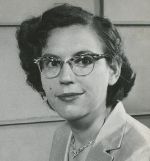 |
| Mary Sherman Morgan (Wiki) |
Hydyne
Mary Sherman (4 Nov 1921 – 4 Aug 2004) graduated as her high school’s valedictorian in 1939 and then enrolled at North Dakota's Minot State University as a chemistry major. WWII intervened and she never completed her degree. Instead, she went to work as a chemist at an Ohio munitions factory that manufactured explosives. When WWII ended, Sherman was recruited by the North American Aviation Rocketdyne division where she predicted the performance of rocket propellant combinations. There she met and married George Richard Morgan, becoming Mary Sherman Morgan. Out of 900 engineers, Morgan was the only woman, and one of a few Rocketdyne engineers without a college degree.
During the Jupiter missile development program, Wernher von Braun’s team needed to improve the performance of the Jupiter-C first stage. Mary Sherman Morgan, with her expertise and experience with new rocket propellants, got the duty and developed a new propellant, Hydyne, which increased the thrust by 12% (93,562 lbT in space at the end of Jupiter-C and Juno I development) while requiring almost no modification to the Redstone. Hydyne is a blend of 60% unsymmetrical dimethylhydrazine (UDMH) and 40% diethylenetriamine (DETA). While Hydyne was a more powerful than ethanol it was also more toxic, which meant the Mercury-Redstone rockets reverted to an ethanol/LOX propellant combination. The first Hydyne-powered Jupiter-A R&D flight, CC-15, took place on 29 Nov 1956. [Bullard, John W. History of the Redstone Missile System (Redstone Arsenal, Alabama: Army Missile Command, 15 Oct 1965, 60)] Hydyne subsequently powered three Jupiter-C nose cone test flights, along with the Juno I rockets that launched America's first satellites into orbit. [https://en.wikipedia.org/wiki/Mary_Sherman_Morgan]
Jupiter C
An object reentering the atmosphere is subjected to extreme heat and dynamic stresses. Engineers working on Jupiter thought they could develop ablative coatings for nose cones that could survive reentry, but they could only be tested by actual reentry. ABMA developed the Jupiter-C with the specific objective of lofting nose cones high enough to test their reentry characteristics.
The Jupiter-C was a Redstone whose center unit was elongated 5.42 ft, providing more propellant for longer burns. Replacing the usual nose unit and aft unit was a rotating high-speed assembly comprising two or three additional stages. Rotation helped with stability and to mitigate thrust imbalances among the rocket motors. Stage 2 consisted of an outer ring of 11 subscale Sergeant missile solid rocket motors, also known as Castor motors. Stage 3 consisted of 3 Castor motors, which were mounted inside the Stage 2 motors. Stage 4 was a single Caster motor. Castor motors were produced by several vendors and varied slightly in size, thrust and burn time. Typically they were 39.4" long, 11.8" in diameter, weighed 92 lb, and produced 1,497 lbT for 6 seconds. [http://www.astronautix.com/c/castorengine.html]
A sub-scale Jupiter nosecone test article was affixed to the top of the high-speed assembly. [Bullard, John W. History of the Redstone Missile System (Redstone Arsenal, Alabama: Army Missile Command, 15 Oct 1965)]
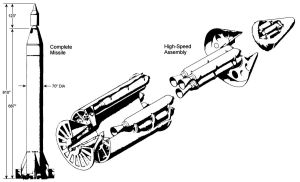 |
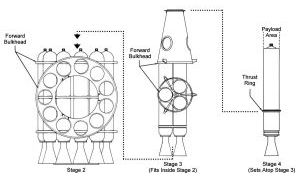 |
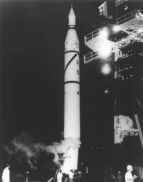 |
| Jupiter-C with High-Speed Assembly (heroicrelics.org) |
High-Speed Assembly Detail (heroicrelics.org) |
Jupiter-C Awating Launch (Wiki) |
Juno I
In order to distinguish among the growing variety of Redstone multi-stage rockets, the name Juno I was suggested to represent those using Jupiter-C technology to launch satellites. A total of six launches were attempted, three of which were successful. These included: Explorer I (31 Jan 1958), the first U.S. satellite; Explorer II (5 Mar 1958), fourth stage failed to ignite; Explorer III (26 Mar 1958), successful; Explorer IV (26 Jul 1958), successful; Explorer V (24 Aug 1958), booster and second stage collided after separation; Beacon (23 Oct 1958), second stage separated from booster due to vibration.
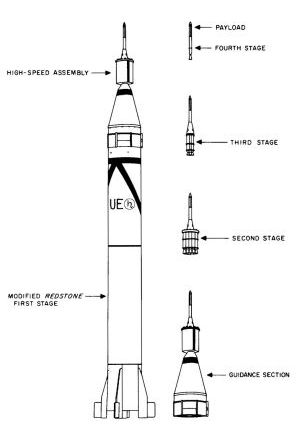 |
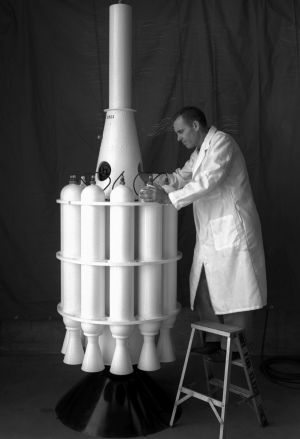 |
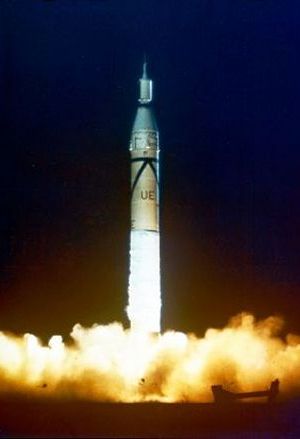 |
| Juno I (heroicrelics.org) | Juno I High-Speed Assembly (heroicrelics.org) | Explorer I Launch (Wiki) |
Mercury-Redstone
One of the most amazing stories in space flight history is the story of Mercury-Redstone, the system that launched the first U.S. astronauts into space. Statistically, the launch history had been the kind of nightmare that rarely inspires confidence. Of the original Redstone and Jupiter-C launches, 16 out of 37 (43%) had some sort of malfunction. Mercury-Redstone was a bit better in that only 2 out of 6 (33%) had a malfunction. That U.S. astronauts would trust such a vehicle with their lives is astounding!
Preparation for the first U.S. manned space flight was an awe-inspiring exercise in engineering, analysis and testing. Much of this is outlined in The Mercury-Redstone Project (13 MB PDF), which makes outstanding reading and is summarized here.
The engineers and planners responsible for the first two manned U.S. space flights faced innumerable challenges including: When is a vehicle ready for manned flight? How is the astronaut saved if a catastrophic failure occurs? How is ground personnel safety provided? How are the efforts of disparate engineering groups integrated?
This thinking led to emergency egress operations, an automatic in-flight abort sensing system, and range safety destruct procedures.
All of this led to a three-step program – redesign, modifications after ground test, and modifications after flight tests.
The redesign consisted of Redstone propellant tank enlargements to increase the nominal burn time from 123.5 sec to 143.5 sec; replacement of the ST-80 stabilized platform with the simpler, more proven and more mature LEV-3 autopilot; enhanced crew safety emphasis, including automatic inflight abort and emergency egress.
Modifications after ground tests mainly involved replacement of components that had failed the vibration test program, including an engine piping elbow, a peroxide tank bracket, and abort rate switch mounting bracket, roll-rate switch wiring, and an antenna mounting stud.
Mercury-Redstone flight testing comprised four missions: MR-1, MR-1a, MR-2 and MR-BD. A sneak circuit in MR-1 resulted in engine shutdown after the booster reached a height of 3.8". A 12" breakable ground strap was added to ensure good grounding as the booster left the launcher. Several changes had to be made to the guidance system hardware to fix anomalies. MR-1a, a repeat of the unsuccessful MR-1 flight, was marginally successful, but there were still anomalies, primarily in the guidance and control. MR-2 also had guidance and control problems, as well as problems with the capsule/booster integration; the chamber pressure controller malfunctioned, causing the LOX supply to be depleted early, initiating an abort condition, firing of the escape system, failure to fire the retro rockets, and high reentry acceleration. The team made changes to the booster that reduced vehicle oscillations and assured correct cutoff timing. These changes were validated by mission MR-BD (booster development), which finally went according to plan.
After three failures in four attempts during Mercury-Redstone development testing, Alan B. Shepard, Jr. had the guts to climb aboard MR-3 on the morning of 5 May 1961 and become the first U.S. astronaut into space during a successful 15 minute sub-orbital flight. Virgil "Gus" Grissom repeated this feat on 21 Jul 1961 in MR-4. [The Mercury-Redstone Project (Huntsville, AL: Saturn/Apollo Systems Office, Dec 1964)]
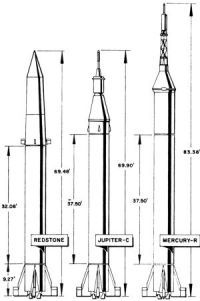 |
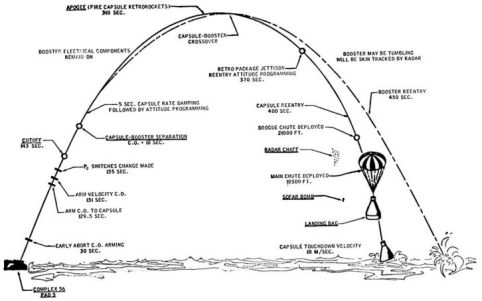 |
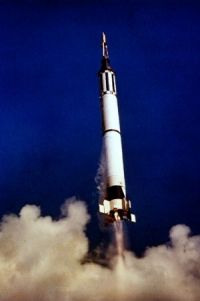 |
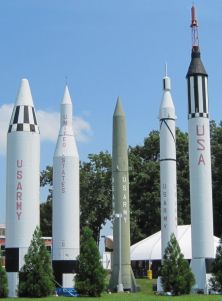 |
| Size Comparison (heroicrelics.org) | Mercury-Redstone Flight Profile (NASA) | MR-3 Launch (NASA) | USSRC Missiles: L to R - Jupiter, Juno II, Redstone, Juno I, Mercury-Redstone |
--- On To Part 4.2 ---